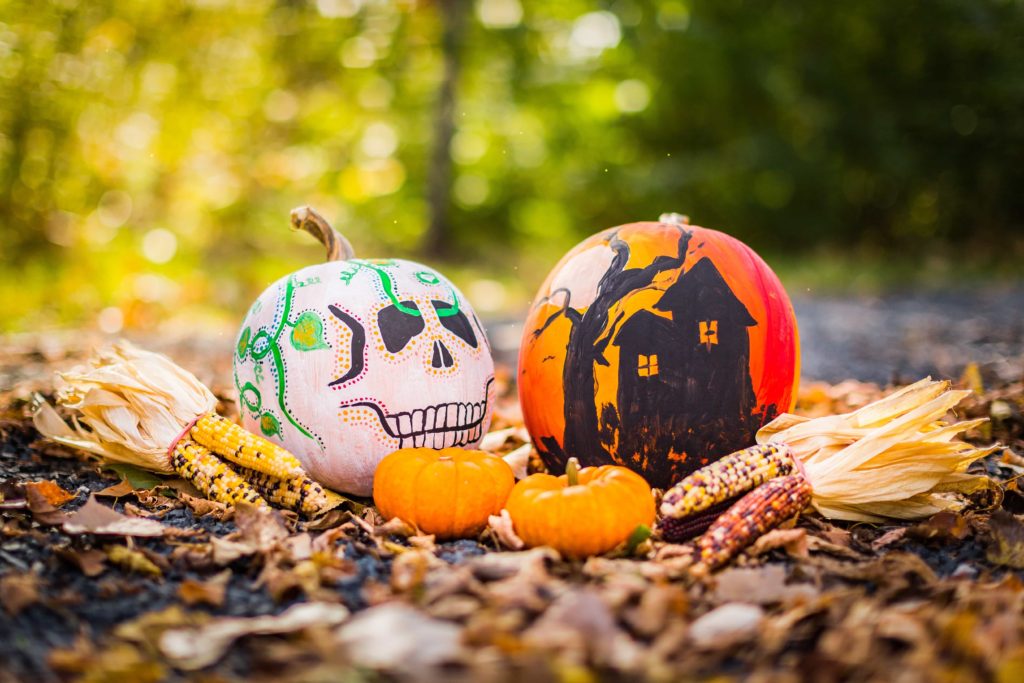
Día de Los Muertos – Day of the Dead and Halloween Traditions
Día de Los Muertos and Halloween have quite a bit in common, but there are important differences as well. Halloween, as practiced today in the U.S., is mostly about dressing in costume and collecting enormous quantities of candy. Symbols of death and otherworldly images are used as decorations, but mainly in a sanitized, non-threatening way.
Day of the Dead, a holiday that spans two days in Mexico, is a time for families to remember departed loved ones, and to feel their presence in the lives of the living. In the United States, we tend to regard death as something final, foreign, something to be feared.

However, in the Mexican tradition, Día de Los Muertos festivities reflect a recognition and acceptance of death as an integral part of the human experience and a belief that dying does not remove a person from family and community. Death is still scary, but it’s confronted with humor, irony, and a touch of fatalism.
In preparation for Día de Los Muertos, much time and care is devoted to cleaning and decorating graves. Elaborate altars, called ofrendas “offerings”, are constructed in honor of dead loved ones, both in homes and in cemeteries. On the altar, photographs of the departed are surrounded by candles; cempasúchil (Mexican marigolds); calaveritas (sugar skulls); written messages; religious items and food, drink, and belongings that were dear to the departed in life.

All of this effort is to invite the souls of the departed to come back for a visit. The departed are still a part of the lives of those who loved them. There is sadness, of course, but there’s also celebration. Eating, drinking, music, and laughter abound as people share humorous stories of the departed. Like a New Orleans funeral, it’s as much about celebrating life as it is about mourning.
History of Día de Los Muertos
Like many religious traditions in Latin America, Day of the Dead is a mixture of ancient native practices and Catholic beliefs. The Aztec festival commemorating the dead occupied a full month in the 16-month calendar. It was presided over by the goddess Mictecacíhuatl, the “Lady of Death,” wife of Mictlantecuhtli, “Lord of the Land of the Dead”.

The figure of the goddess of death has come to be associated with La Catrina, an elegant skeleton dressed in the style of an upper-class 19th-century Mexican woman.
When is Día de Muertos Celebrated?
In the modern Mexican tradition, Día de Muertos festivities coincide with the Catholic holy days of All Saints’ Day, November 1, and All Souls’ Day, November 2. The 1st of November is Día de los Inocentes (Day of the Innocents) or Día de los Angelitos (Day of the Little Angels), dedicated to the memory of children who have died, while the 2nd of Nov. is Día de Los Muertos, when departed adults are honored. It is believed that the souls of the departed come back to visit loved ones on their respective days.
It’s no wonder that Día de Los Muertos is being celebrated in a growing number of U.S. cities and towns. Brought here by immigrants, the color, beauty, and spiritual depth of this Mexican tradition resonates with more and more Americans.
Along with the ofrendas, festivities, and pan de muerto (a Mexican sweet bread baked specially for the occasion), Dia de Los Muertos offers a chance to celebrate the lives of those who are no longer with us.
The Book of Life by Guillermo del Toro
Guillermo del Toro’s animated film The Book of Life, is based on the Mexican tradition of Día de Los Muertos (Day of the Dead). It’s a sign of the ever-increasing cultural cross-fertilization between Mexico and the United States.
Delve Deeper into Latin American Culture by Learning Spanish
Want to make Spanish learning a part of your everyday life?
Start listening to popular Spanish music, like Reggaeton or Latin Rock, or download a free week of the Pimsleur app to start listening, speaking, and testing your Spanish skills.

3 Comments for "What is the Day of the Dead?"